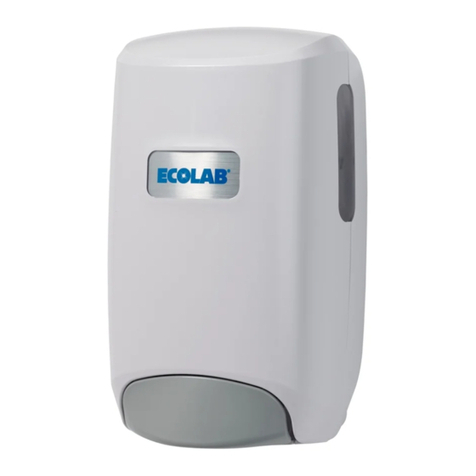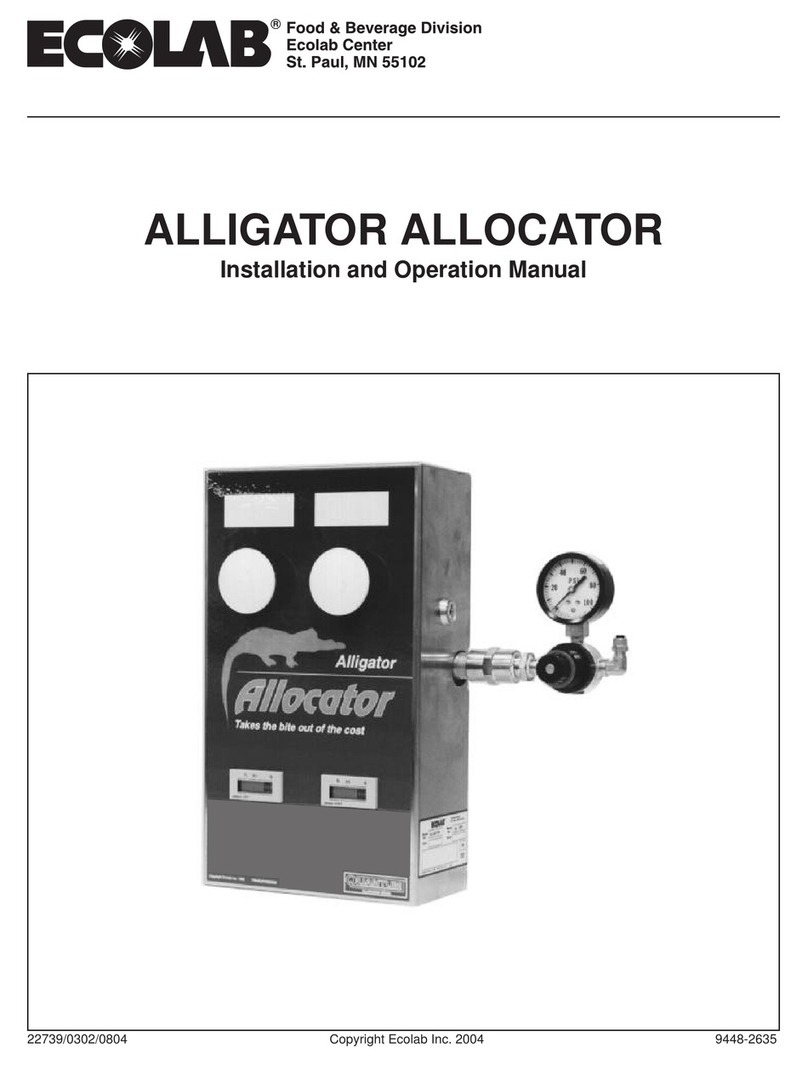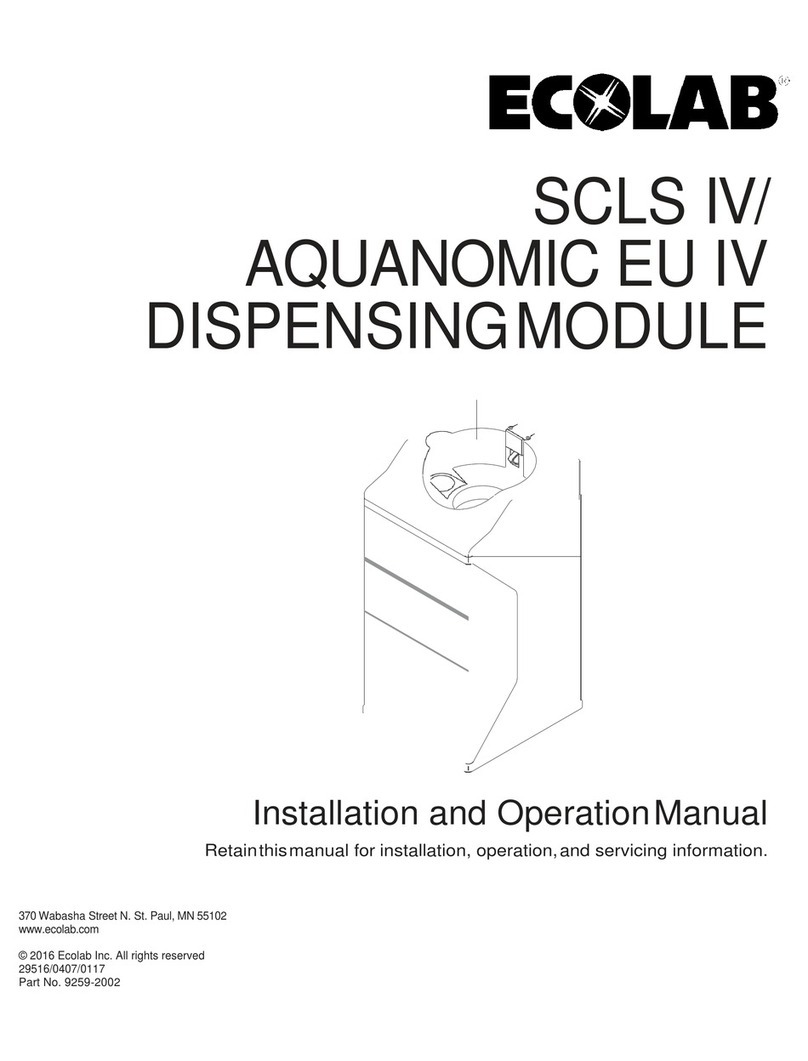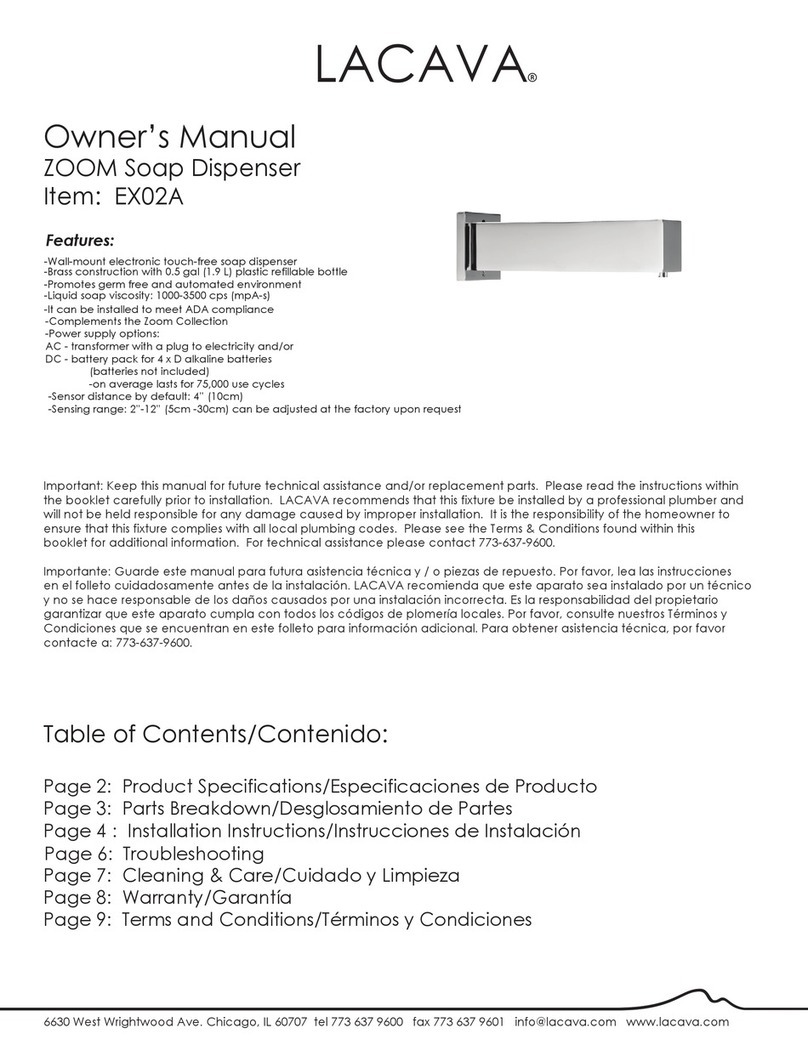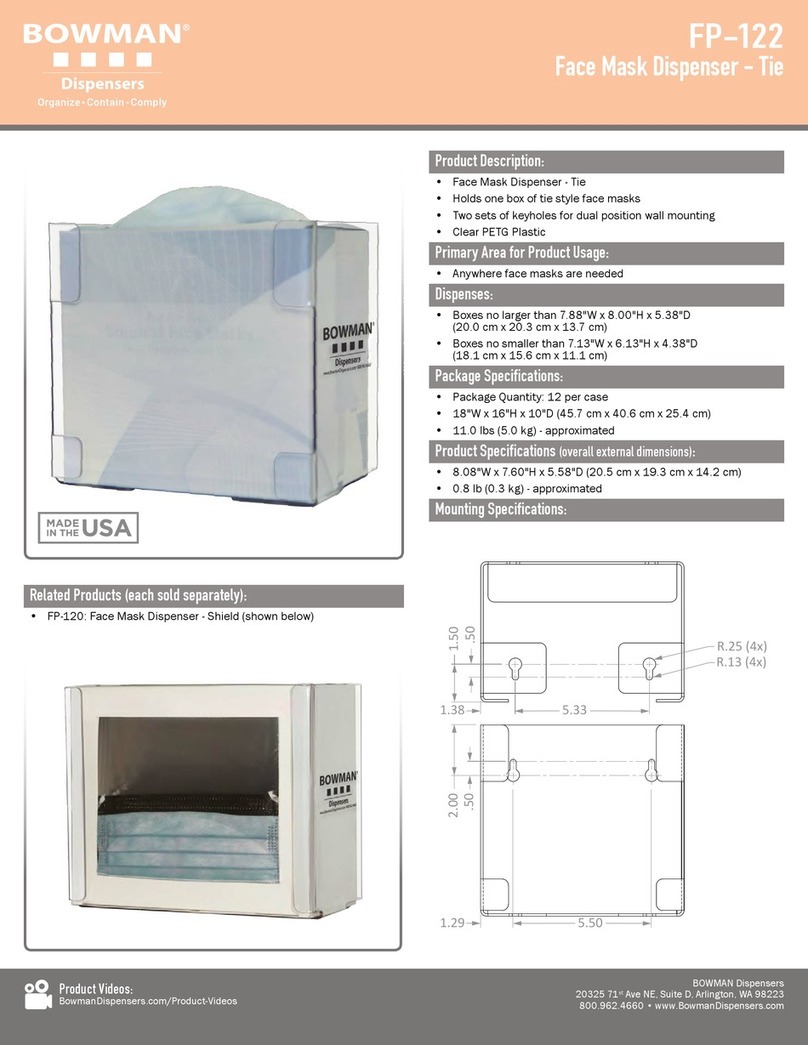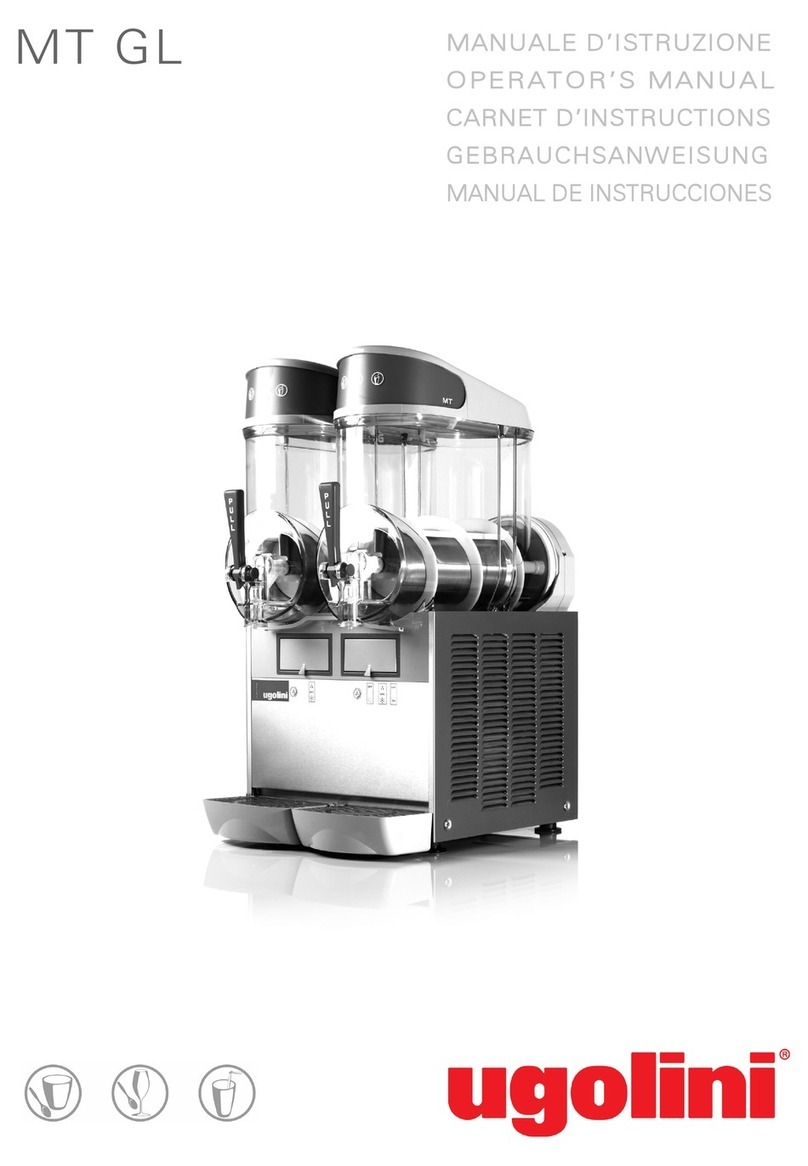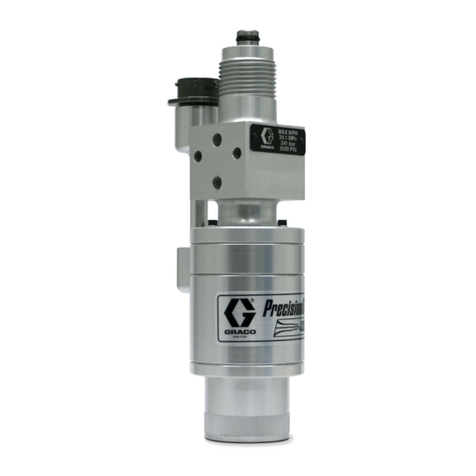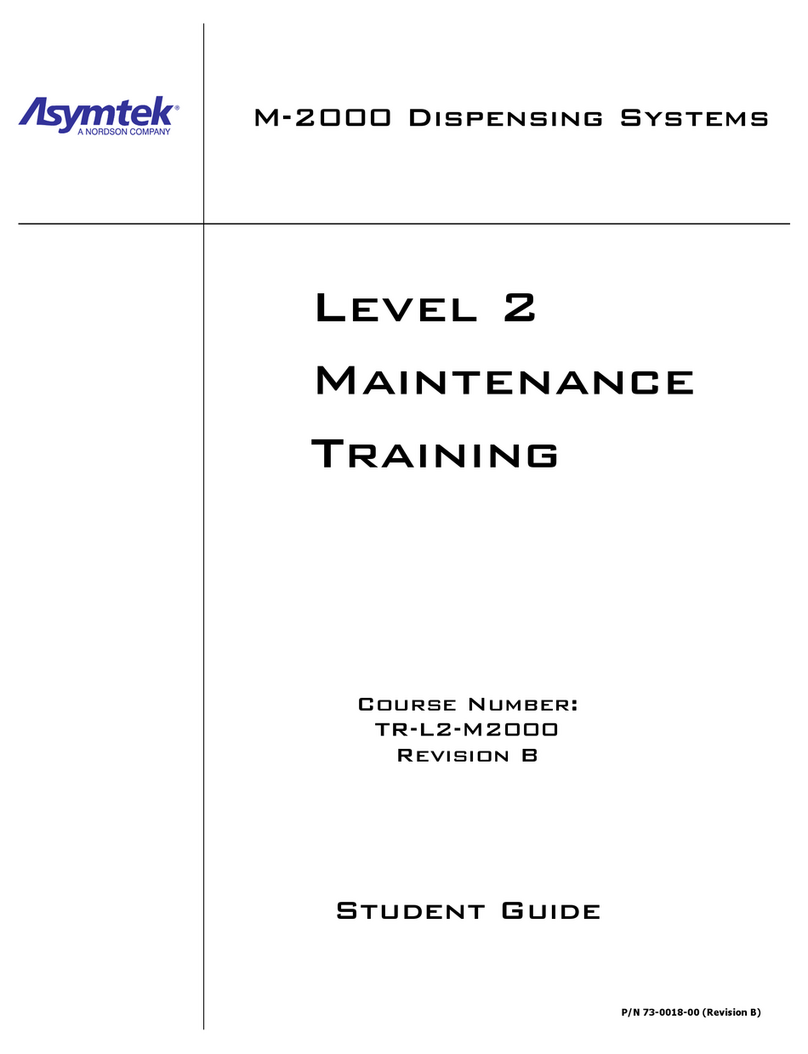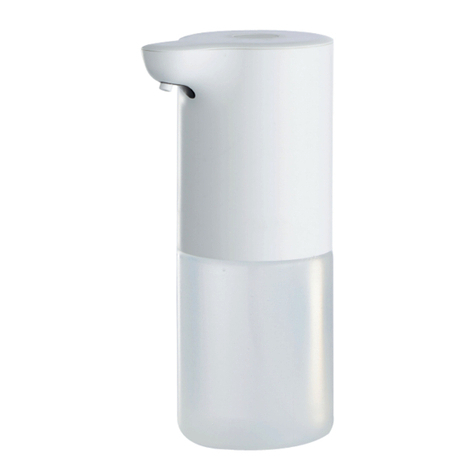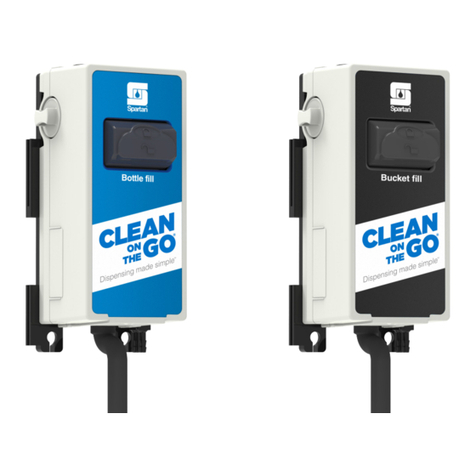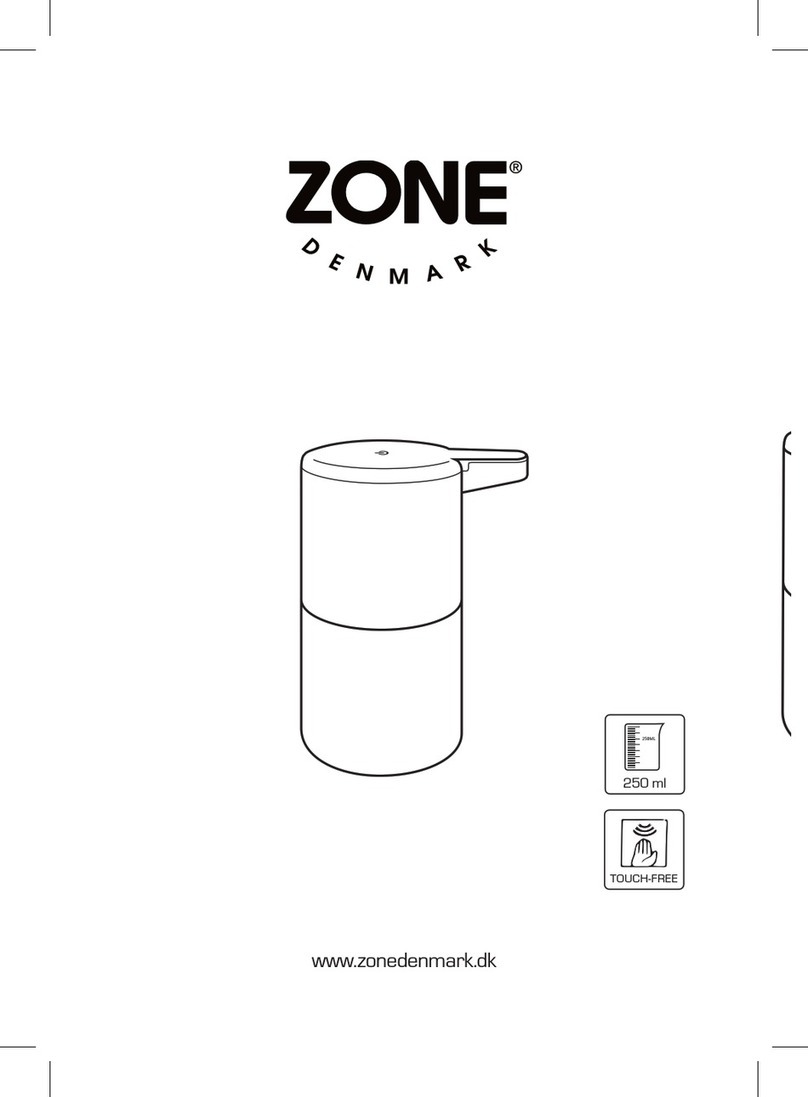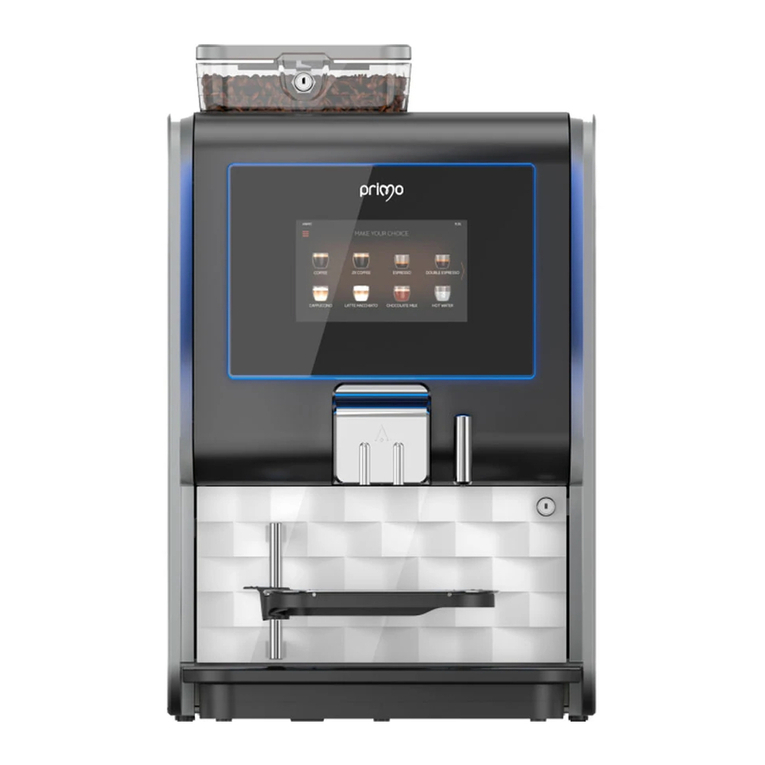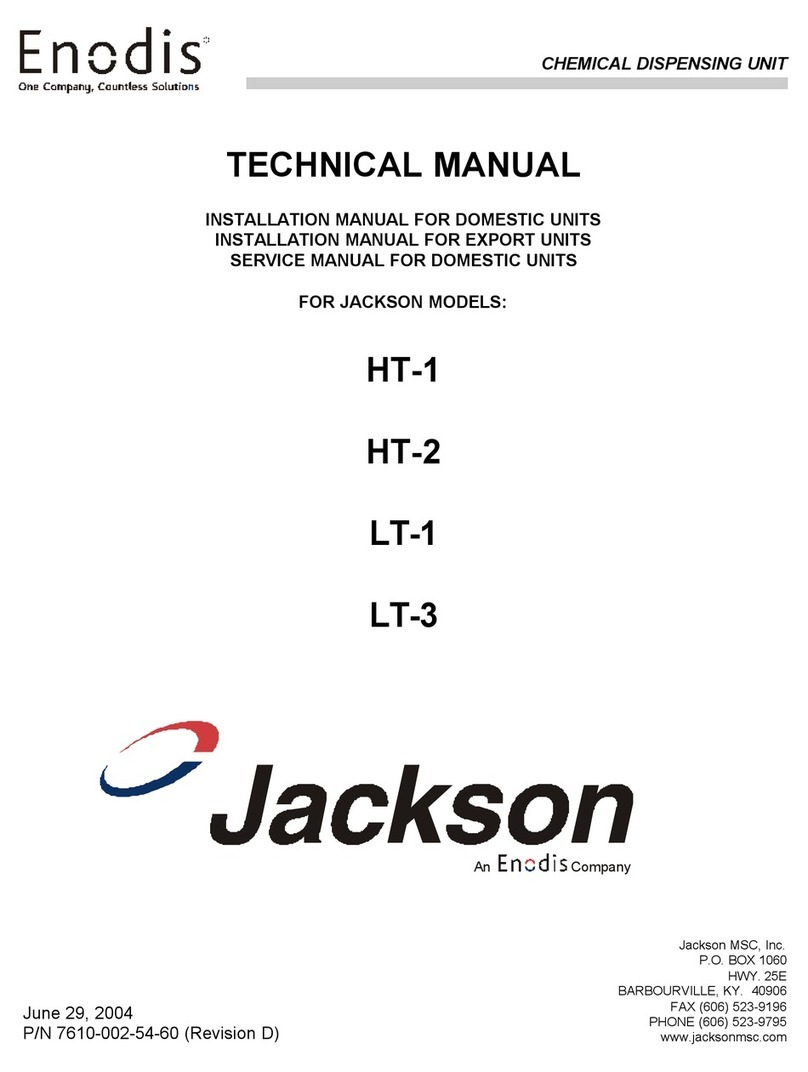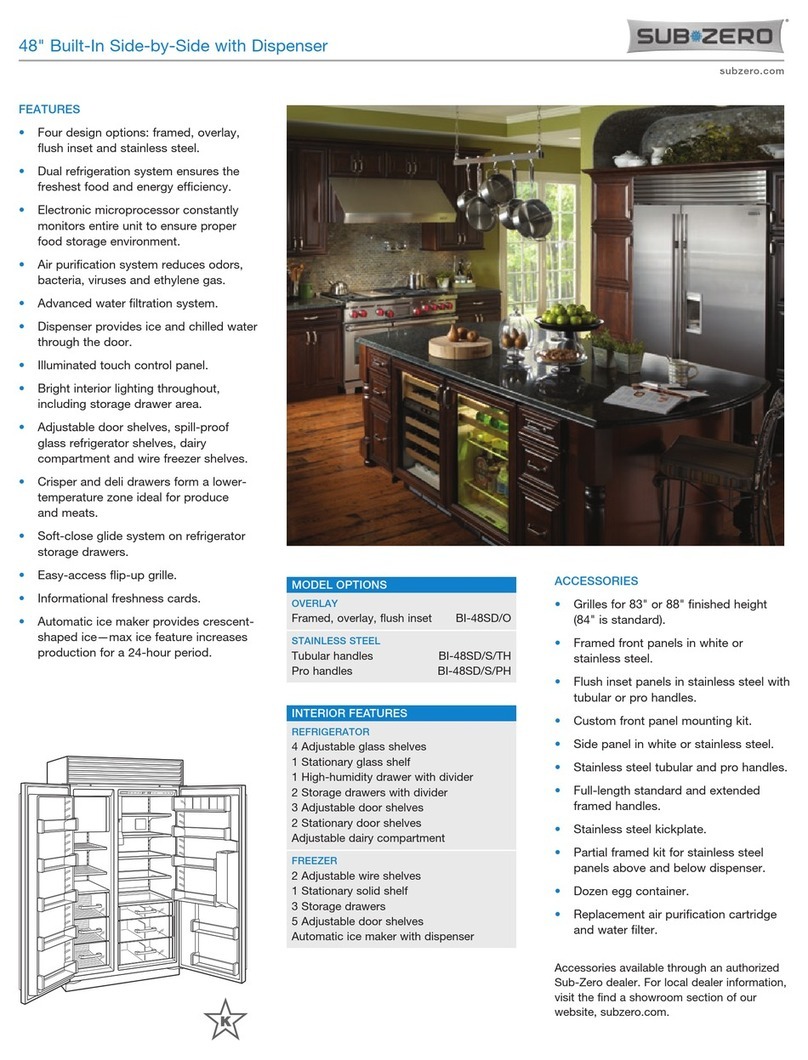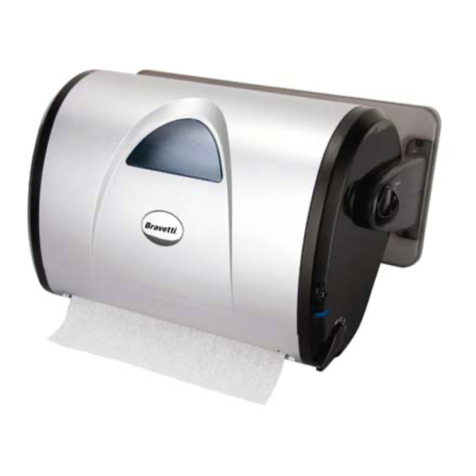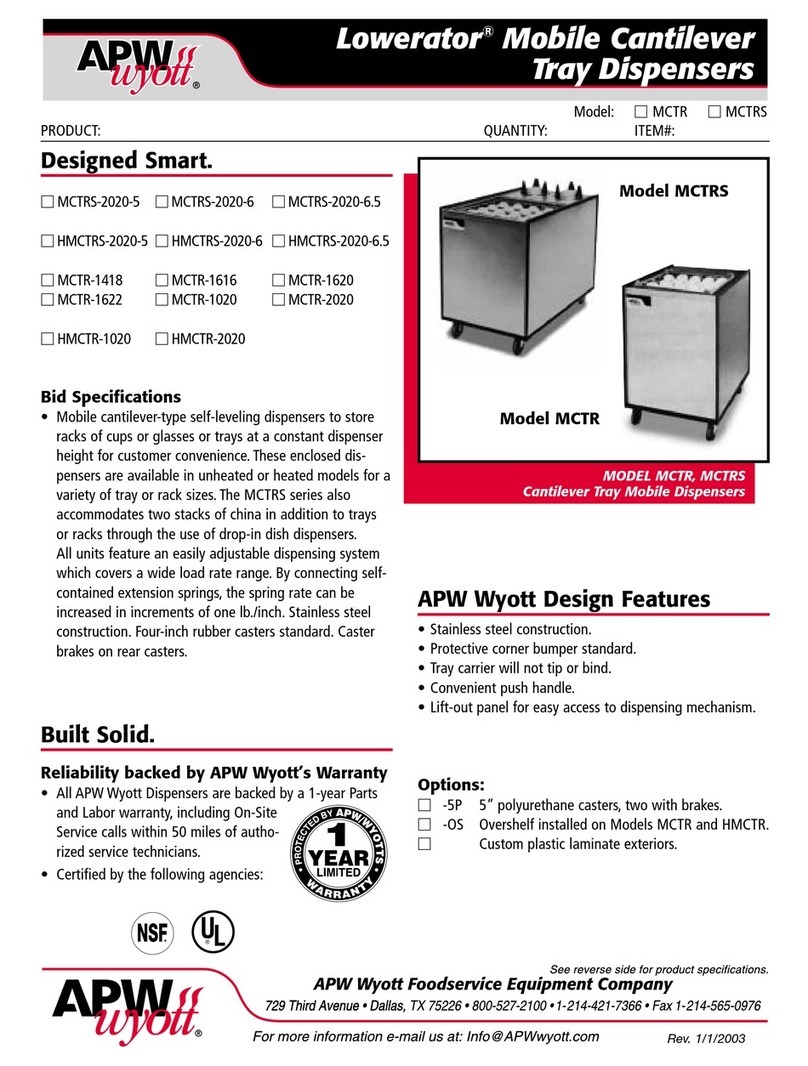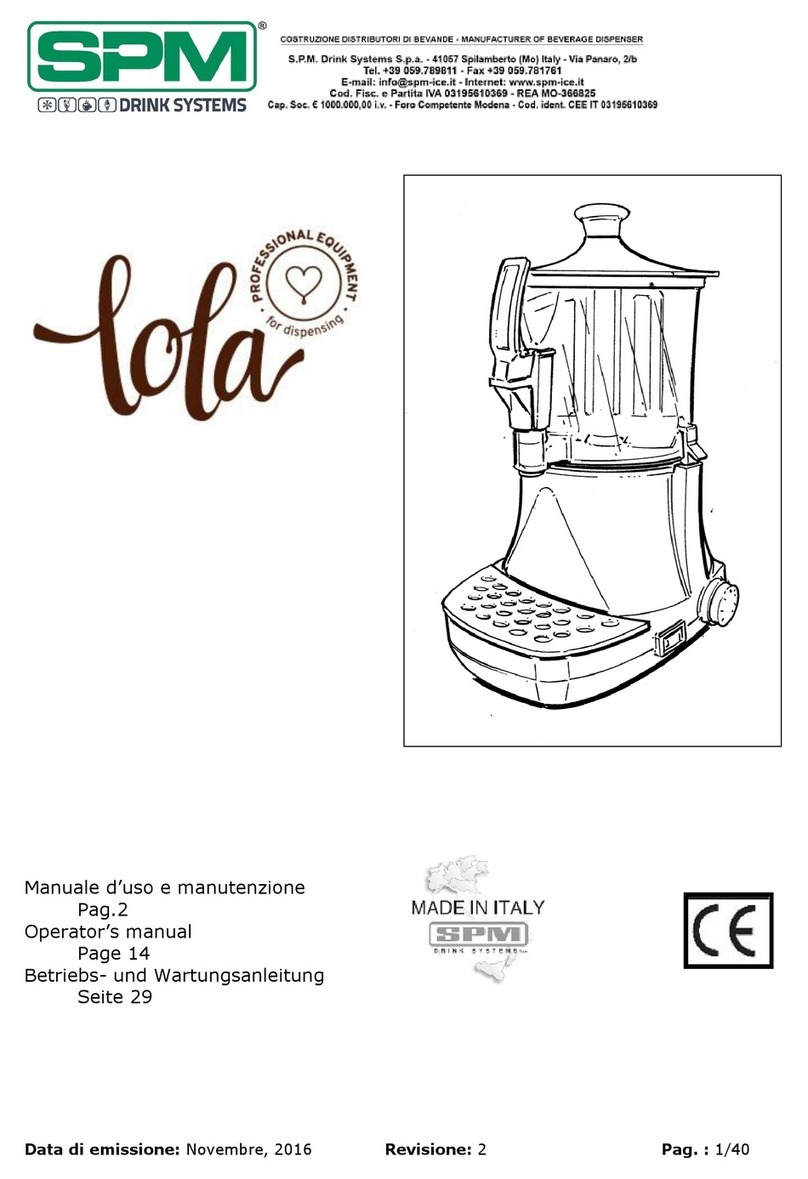Ecolab GEOCENTER User manual

GEOCENTER
Installation and Operation Manual
Dispenser Complete 9223-1091
26392/0406/0409 Copyright Ecolab Inc. 2009 9223-2610

This page intended
to be blank.

iii
TABLE OF CONTENTS
GEOCENTER
Installation and Operation Manual
Section . . .
1.0 PREFACE ......................................................................................................... 1
2.0 INTRODUCTION............................................................................................... 2
3.0 SPECIFICATIONS ............................................................................................ 3
3.1 Dimensions............................................................................................... 3
3.2 Access Requirements .............................................................................. 3
3.3 Product Pickup and Discharge ................................................................. 3
3.4 Electrical Requirements ........................................................................... 3
3.5 Plumbing Requirements ........................................................................... 4
3.6 Components Supplied .............................................................................. 4
3.7 Components Not Supplied ....................................................................... 4
4.0 INSTALLATION PROCEDURES...................................................................... 5
4.1 Pre-Planning the Installation .................................................................... 5
4.2 Installing the Transformer......................................................................... 5
4.3 Mounting the GeoCenter.......................................................................... 5
4.4 Mounting Sensor in Wash Tank................................................................ 5
4.5 Geosystem Detergent Dispenser Installation........................................... 5
4.6 VANGUARD Wash Max Installation ......................................................... 5
4.7 Geosystem Rinse Dispenser.................................................................... 6
4.8 Rinse Injector Connections ...................................................................... 6
4.9 Hydraulic Connections and Visual Flow Indicator .................................... 6
5.0 ELECTRICAL CONNECTIONS........................................................................ 7
5.1 Transformer Wiring................................................................................... 7
5.2 440 Volt Machine Power Supply............................................................... 8
5.3 S-2000 Sensor Wire Connections ............................................................ 8
5.4 Geosystem Detergent Dispenser Wiring Connections ............................. 8
5.5 Geosystem Solid Rinse Reservoir Connections....................................... 8
5.6 VANGUARD Wash Max Wiring Connections ........................................... 8
5.7 Two Pole Probe Wire Connections........................................................... 8
6.0 SYSTEM ADJUSTMENTS ............................................................................... 9
6.1 Cell/Sensor Selection ............................................................................... 9
6.2 Concentration Adjustment ........................................................................ 9
6.3 Feed Adjustment Potentiometers ............................................................. 9
6.4 Sonalert®Volume Adjustment................................................................. 10
6.5 Sonalert®Alarm Delay ............................................................................ 10
6.6 Rinse Speed Control .............................................................................. 10
6.7 Timed Feed ............................................................................................ 10
6.8 Feed Delay ............................................................................................. 10

iv
7.0 SYSTEM OPERATING FEATURES ............................................................... 11
7.1 Power Lights............................................................................................11
7.2 Feed Light ...............................................................................................11
7.3 100% Light ..............................................................................................11
7.4 Temperature Compensation ....................................................................11
7.5 Optional Jumper Settings ........................................................................11
8.0 SERVICE ........................................................................................................ 12
8.1 Regular Inspection ................................................................................. 12
8.2 Squeeze Tube Replacement Instructions............................................... 12
9.0 TROUBLESHOOTING.................................................................................... 13
9.1 Unit does not operate - No Power Light. ................................................ 13
9.2 Unit does not feed - Power Light and Feed Light on.............................. 13
9.3 Unit does not feed - Power Light on, Feed Light not on......................... 14
9.4 Feeds continuously - Feed Light not on. ................................................ 14
9.5 Feeds continuously - Feed Light on. ...................................................... 14
9.6 Fluctuating titration. ................................................................................ 15
9.7 Excessive detergent consumption.......................................................... 15
9.8 Rinse Injector does not activate. ............................................................ 15
9.9 Rinse Injector runs, no rinse additive being injected.............................. 16
9.10 Rinse Injector runs continuously ............................................................ 16
9.11 Rinse Injector will not prime. .................................................................. 16
9.12 Excessive squeeze tube wear. ............................................................... 16
9.13 Fuse on Speed Rinse P.C. board is blowing repeatedly......................... 16
10.0 REPLACEMENT PARTS................................................................................ 17
11.0 OPTIONAL PRESSURE SWITCH INSTALLATION....................................... 18

1
1.0 PREFACE
This manual has been written to present the basic installa-
tion and operation characteristics of the GeoCenter. This
manual applies, in its entirety, to current units.
Guidelines will be suggested in reference to the preferred
method of installation, however, the variety of equipment
and the surrounding physical environment will dictate the
actual installation of the GeoCenter.
WARNING: These installation and servicing in-
structions are for use by qualied personnel only.
The installation must be made in accordance with
local plumbing and electrical codes.

2
2.0 INTRODUCTION
The GeoCenter is a self contained detergent monitoring
and dispensing controller combined with a rinse injector in
the same cabinet.
The system includes two (2) separate printed circuit control
boards, one each for the detergent control system and the
rinse injector, transformers for each, and a solenoid valve.
These components are contained in a housing that is com-
pact in size but provides easy access for adjustments and
servicing.
The Detergent Control System features include:
• S-2000 SENSOR must be used with the Geosystem
products.
• Two Pole Probe for soft to medium hard water and where
soft metals are not being washed in the machine.
The controller provides overshoot control by “pulse feeding”
detergent when wash tank concentration is near the desired
control point. Visual indicators signal concentration status
of the wash tank.
• A “FEED” light will illuminate when concentration is
below the set level.
• A “100%” light will illuminate when at or above the set
time to titrate the wash solution.
Consistent detergent control is achieved over a wide range
of wash tank temperatures through the temperature com-
pensation feature when using the S-2000 Sensor.
The detergent controller also indicates low power supply
to the system.
The Rinse Injector System features Include:
• Double roller peristaltic pump
• Squeeze tubes with different delivery rates for high or
low volume requirements.
• Variable speed DC motor, 3-36 RPM.
• Regulated DC Speed Rinse Control P.C. Board.
• Selector switch to run continuously or to time out within
51 seconds.
• Start delay of 0-10 seconds.

3
6" MIN (US)
30 cm (INT'L)
WATER FLOW
H
D
W
3.0 SPECIFICATIONS
System Diagram
3.4 Electrical Requirements
source supplied through two 30 VA transformers. The
transformer primaries can be either 115 or 230 volts. One
transformer provides power for the detergent control and
the other provides power for the rinse injector.
If the primary voltage is 440 volts, two separate, externally
mounted transformers will be required. The 24 volt secondary
wiring of one transformer will be connected directly to the
Detergent Controller P.C. Board.The 24 volt secondary of the
second transformer will be connected directly to the Rinse
Speed Control P.C. Board. Both the internal transformers
can be removed when wiring for a 440 volt installation.
IMPORTANT: Make sure the power source is turned off
3.1 Dimensions
3.2 Access Requirements
Mounting location must allow cabinet cover to swing down
the right side to service the peristaltic pump, and on the left
for electrical service.
3.3 Product Pickup and Discharge
exceed 10' (3 meters) in length. The maximum discharge
tubing length of 150' (45 meters) will accommodate
remote installations of the GeoCenter. If tubing length
exceeds 50' (15 meters) the tubing must be replaced with
SOLENOID VALVE
(REFER TO FIGURE 4-4 ON
PAGE 6.)
DETERGENT CONTROLLER
P.C. BOARD
RINSE SPEED
CONTROL P.C. BOARD
TRANSFORMER ASSEMBLY
(REFER TO FIGURE 5-2 ON
INJECTION POINT
TO GEOSYSTEM
RINSE DISPENSER
S-2000
SENSOR
VISUAL FLOW INDICATOR

4
3.7 Components Not Supplied
• Geosystem Detergent Dispenser
• Geosystem Rinse Dispenser
• Wiring and wiring connectors
• 440 volt transformers (if required)
• Two Pole Probe
• VANGUARD Wash Max
• Pressure Switch
before beginning wiring connections or servicing the
high voltage portion of the system.
codes and Ecolab®Installation Standards. All high voltage
Wiring from the power source to the transformer must be
enclosed in conduit, seal-tite or other housing approved for
damp locations.
3.5 Plumbing Requirements
Water supply tubing from the source to the solenoid valve
at the GeoCenter, and from the solenoid valve to the
copper tubing.
Refer to the Installation and Operation Manual of the
Geosystem Detergent Dispenser used for this application
to aid in the installation of the GeoCenter.
3.6 Components Supplied
• Detergent Controller P.C. Board
• Solenoid Valve
• 2 30 VA Transformers
• Cell Wash Tank Connector
• Rinse Speed Control P.C. Board
• S-2000 cell with 12 foot cable

5
Figure 4-1
4.0 INSTALLATION PROCEDURES
4.1 Pre-Planning the Installation
There is no substitute for planning the installation prior to
beginning the work, minutes in planning may save hours in
installation time. The following items should be taken into
• Allow visual displays on the front of the cabinet to be in
full view of the operator.
• Permit shortest possible tube, wire, and conduit
lengths
• Provide accessibility for adjustments and servicing.
heat as possible.
The following items should be taken into consideration before
installing the Sensor. The sensor should be located in an
• A minimum 2" (5 cm) from the tank bottom, sidewall,
• As far as possible (2" minimum) (5 cm) from heater
elements or coils.
• Protection from physical hazards.
• For constant submersion of all parts of the sensor in
the wash water. This is a particular concern on shallow
tank machines.
NOTE: The S-2000 Sensor is provided with a 12' cable
and mounts from the inside of the washtank. Sufcient
clearance on the inside is required to allow insertion/
removal of the sensor.
NOTE: A S-2000 sensor with 24' cable is available where
necessary (9212-2316).
4.2 Installing the Transformer
1. Mount the plastic transformer enclosure assembly into
the plastic GeoCenter enclosure. (Refer to Figure 4-1).
4.3 Mounting the GeoCenter
1. Mount the GeoCenter cabinet to the wall using the
supplied screws, washers and plastic wall anchors. The
GeoCenter cabinet may also be installed on top of the
dish machine, using the universal mounting brackets,
and may be the preferred location in some installations.
The installa
tion should be secure, neat and square, refer to
Figure 4-1.
4.4 Mounting Sensor in Wash Tank
Review Item 4.1, Pre-planning the Installation, before the
installation begins.
IMPORTANT: Before drilling the hole check for
obstructions both inside and outside of the wash
tank.
SCREW
2. Properly DEBURR the hole.
3. Attach the sensor connector to the tank using the pro-
vided metal lock nut and the stainless steel and rubber
washers on both the inside and outside surfaces of
the tank wall. Regardless of which sensor is used, the
packing nut end of the tank connector must be on the
outside of the machine wall, refer to Figure 4-2.
4. Position the sensor by sliding it through the connector
opening and tightening the packing nut.
4.5 Geosystem Detergent Dispenser
Installation
1. Install the desired Geosystem Detergent Dispenser
following the installation instructions provided for that
unit.
4.6 VANGUARD Wash Max Installation
1. Install the desired VANGUARD Wash Max following the
installation instructions provided for that unit.
S-2000 SENSOR
SENSOR
CABLE
Figure 4-2

6
6" MIN (US)
30 cm (INT'L)
WATER FLOW
Visual Flow
Indicator
TUBE
TUBE
TUBE CLAMP
INDICATOR TUBE
TUBE CLAMP
TUBE
TUBE
Figure 4-3
4.7 Geosystem Rinse Dispenser
1. Install the Geosystem Rinse Dispenser following the
installation instructions provided for that unit.
4.8 Rinse Injector Connections
Identify the point at which rinse additive will be injected into
refer to Figure 4-3.
NOTE: The injection point has to be installed a minimum
of 6" (15.2 cm.) below the vacuum breaker with the cabinet
mounted at or below that point. In many International
accounts the minimum distance beneath the vacuum
breaker is 30 cm. (11.8"). Install tting using Teon tape
or pipe sealant to prevent leakage.
4.9 Hydraulic Connections and Visual Flow
Indicator
refer
to Figure 4-3.
Note: The visual ow indicator is required for NSF
listing.
2.
3. Insert this injection tubing assembly fully into the outlet
end of the Flow Indicator tube, also called the sight
tube.
4. Secure all connections with the clamps provided.
5. Complete the outlet of the Visual Flow Indicator in the
Refer to Figure 4-3.
IMPORTANT: When the product is being injected into
the nal rinse line, movement of the product will be
visible in the ow indicator tube. The dishmachine
operator must be instructed to observe the Flow
Indicator periodically to insure that product is in
fact being dispensed.
with the rinse injector to the inlet side of the pump.
the inlet side of the solenoid valve located at the bottom
on the GeoCenter cabinet, refer to Figure 4-4.
solenoid valve to the Geosystem Detergent Dispenser.
Refer to the Installation and Operation Manual of the
Geosystem Detergent Dispenser used to determine
WATER IN
SOLENOID
VALVE
TO GEOSYSTEM
DETERGENT
DISPENSER
VACUUM
INJECTION
FITTING
VALVE
PRESSURE
TO
GEOSYSTEM
RINSE
DISPENSER
Figure 4-4

7
NOTES:
1. JP1 and JP2 jumpers in " PEN" position
2. FIELD WIRING
3. FACTORY WIRING
RINSE SPEED CONTROL
P.C. BOARD
T
I
M
E
D
R
U
N
DELAYSPEED
TIME
F
R
O
N
T
115/230
VAC
B
A
C
K
24 VAC
BOTTOM
TRANSFORMER
G
R
A
Y
G
R
A
Y
(+)
(-)
MOTOR
R
E
D
B
L
A
C
K
Y
E
L
L
O
W
Y
E
L
L
O
W
115 V AC WIRING
RED
BLUE
YELLOW
BLACK
115 VAC
24 VAC
SECONDARY
SIDE
RED
YELLOW
BLUE
230 V AC WIRING
BLACK
24 VAC
SECONDARY
SIDE
230 VAC
F
R
O
N
T
TWO-POLE
CELL
R
E
D
B
L
A
C
K
/
S
H
I
E
L
D
B
L
U
E
/
S
H
I
E
L
D
W
H
I
T
E
B
R
O
W
N
2
4
V
D
C
SONALERT
ALARM
DETERGENT CONTROLLER P.C. BOARD
S-2000
SENSOR
O
R
A
N
G
E
B
A
C
K
F
R
O
N
T
SOLENOID
VALVE
BLUE
BLUE
+
-
115/230
VAC
B
A
C
K
24 VAC
WIRE NUTS
RESERVOIR
LID SWITCH
TOP
TRANSFORMER
2
4
V
A
C
O
R
A
N
G
E
V
I
O
L
E
T
B
L
A
C
K
R
E
D
V
I
O
L
E
T
+
-
1 2 3 4 5 6 7 8
SOLID
RINSE
RESERVOIR
RED
BLACK
GREEN
WHITE
HI S26
ON
10 11 12 13 14 15 16 17 18 19 20 21 22 23
OFF
FEED
ALARM
VOLUME
ALARM DELAY
TITRATION
ALARM
100%
POWER
LED LED
JP2
FEED OFF
FEED ADJUST
5.0 ELECTRICAL CONNECTIONS
Figure 5-1
5.1 Transformer Wiring
The GeoCenter is shipped with two (2) 30 VA transformers,
one for the detergent control system and the other for the
rinse injector. Install the assembly into the GeoCenter
according to Figure 5-2.
Both transformers in the GeoCenter should be connected
to the single power source, refer to Figure 5-1.
On Door Type Dishmachines, two (2) separate power
sources from the dishmachine are required.
A power source that is activated during the wash cycle of
the machine should be connected to the top transformer.
Make sure to wire the transformer for the proper voltage,
refer to Figure 5-1.
The power source for the rinse injector should be connected
to the bottom transformer. Make sure to wire the transformer
for the proper voltage.

8
Figure 5-2
5.2 440 Volt Machine Power Supply
NOTE: Most 440 volt machines will provide a source of
115 or 220 volts for the dispenser supply. If only 440 volts
is available, it will be necessary to externally mount two
440 to 24 volt transformers. The transformers shipped
with the GeoCenter will not be used, and it is suggested
that these transformers not be installed.
1. Remove the built-in transformers from the GeoCenter
Cabinet, refer to Figure 5-2.
2. Connect one of the 24 volt leads, using a butt-
connector or a wire nut, from the external transformer
to the two VIOLET wires normally connected to the top
transformer.
3. Connectthe singleORANGEwiretotheothertransformer
lead.
4. Connect one of the 24 volt leads using a butt connector
to one of the GRAY wires normally connected to the
bottom transformer.
5. Connect the other wire in the same manner.
5.3 S-2000 Sensor Wire Connections
1. Attach the BROWN wire to terminal #15, refer to Figure
5-1.
5. Attach the RED wire to terminal #11.
6. Ensure JP1 and JP2 on the PC Board are only installed
on one pin.
5.4 Geosystem Detergent Dispenser Wiring
Connections
The Geosystem Detergent Dispenser features a switch on
the lid to interrupt detergent feed if the lid is opened. (Use
a 2 conductor cable between the GeoCenter and Detergent
units).
At the GeoCenter (Refer to Figure 5-1 on page 7):
• Wire nut the leads from the 2 conductor cable to the
5.5 Geosystem Solid Rinse Reservoir Connec-
tions
The Geosystem Solid Rinse injector reservoir features a
lid switch to interrupt water spray to the rinse additive if the
lid is opened.
TRANSFORMER
ASSEMBLY
-
nals #1 & #2 on the green Phoenix connector.
• The black and red wires are connected to terminals #4
IMPORTANT: RED must be connected to #7. BLACK
must connect to #4.
NOTE: This refers only to the Solid Rinse Additive dis-
penser. Hook up the Geomax unit for use with liquid
rinse additives.
5.6 VANGUARD Wash Max Wiring Connec-
tions
The VANGUARD Wash Max features a safety switch on
the lid to interrupt detergent feed if the lid is opened. A 20'
two conductor cable is connected to the unit to help instal-
lation.
At the VANGUARD GeoCenter (Refer to Figure 5-1 on
BLUE wires provided with the wire nuts.
5.7 Two Pole Probe Wire Connections
1. At the Two Pole Probe, connect the cell wiring to the
2 screws terminals. Leave enough slack in the wire to
allow removal of the cell from the connector without
having to disconnect the wire (refer to Figure 5-1).
2. At the GeoCenter connect the cell wires to TERMINALS
#10 and #11.
3. Ensure JP2 on the PC Board is installed in the "S26"
position.

9
6.0 SYSTEM ADJUSTMENTS
DETERGENT CONTROLLER P.C. BOARD
Figure 6-1
6.1 Cell/Sensor Selection
Ensure jumper JP2 on the detergent controller PC board is
sensor operation, the jumper should only be installed on
ONE pin of JP2.
For two-pole probe operation, the jumper should be installed
on the right two pins of JP2, labeled "S26".
6.2 Concentration Adjustment
Concentration versus Conductivity
When the detergent is dissolved in the wash tank, it produces
a certain concentration of product. A given concentration
of product will, in turn, produce a corresponding conductiv-
ity
the detergent controller. The controller attempts to reach
a desired solution concentration by using the conductivity
signal to control when to feed detergent product into the
wash tank.
wash tank water. The detergent controller cannot distinguish
between the conductivity signal produced by the water and
that produced by the dissolved detergent.
For this reason, the setting of the TITRATION DIP switch
should be viewed as a starting point that may require adjust-
ing once the wash tank is titrated.
Titration Adjustment
Adjustment of the wash tank concentration is done using
the six position TITRATION DIP switch on the detergent
controller PC board. The individual positions on this DIP
switch are labeled 1 through 6. Sliding a position to the left
will turn that position ON. Sliding a position to the right will
turn that position OFF. When a position is ON, the detergent
controller will add detergent to the wash tank according to
POSITION ON 1 2 3 4 5 6
APPROX. #
APPROX. #
When multiple positions are ON, the detergent controller
will add all positions together to achieve the desired tank
concentration.
Example using Standard Drops:
1. Assume a desired tank concentration of 14 standard
drops is required. Start by turning positions 1and 2and
3ON
2. Allow the detergent controller to feed until the 100%
TITRATION ADJUSTMENT
SONALERT®ALARM DE-
LAY ADJUSTMENT
SONALERT®
ALARM VOLUME
ADJUSTMENT
SELECTION
FEED ADJUST PO-
TENTIOMETERS
Note: JP1 and JP2
jumpers in "open"
position.
solution.
3. If the actual titration measurement is only 10 drops, the
wash tank water conductivity is already adding a read-
ing of 4 drops to the measurement. The TITRATION
additional detergent to the tank.
4. Turn positions 2and 3OFF and position 4ON. This
results in positions 1and 4
5. Repeat step 2. This should now provide the desired
concentration.
6.3 Feed Adjustment Potentiometers
of the set point, the dispenser will provide an “on-off” pulse
feed mode to control overshoot.
These potentiometers determine the duration of the “on-off”
pulses. This allows for minimum overshoot dependent upon
the detergent dispensing rate, refer to Figure 6-1.
The normal setting (as factory set) is both pots being in the
full counter-clockwise position, providing for a 1 second “on”
pulse and a 1 second “off” pulse. This is desirable for most
operating conditions.
These are adjustable up to a maximum of 12 seconds. If
the detergent delivery rate is very slow, such as might be
encountered with low feed water temperature to the reservoir,
it may be desirable to increase the “on” pulse time.
In a very large wash tank, it may be desirable to increase
the “off” to allow the detergent to disperse evenly throughout
the wash tank before further feeding occur.

10
RINSE SPEED CONTROL P.C. BOARD
6.4 Sonalert®Volume Adjustment
1. Turn all alarm delay switches off.
2. Put the unit into a feed mode by temporarily turning on
additional titration switches and disrupting detergent feed
by holding open the Geosystem Detergent Dispenser
lid.
3. When the Sonalert®is activated, set the volume using
volume, refer to Figure 6-1.
The Sonalert®volume should be loud enough to be heard
over the normal noise levels in the dish room , and yet not
too loud that it may disturb customers in the dining room.
6.5 Sonalert®Alarm Delay
1. Set the alarm delay by using the 10 position dip switch,
refer to Figure 6-1.
NOTE: On Door Type Machines, the delay should be
approximately 30-35 seconds to allow it to be activated
before the wash cycle is complete.
NOTE: On Conveyer Machines, (unless equipped with
a D-ENERGIZER or other time-out device) the delay
should be a minimum of 2 minutes.
6.6 Rinse Speed Control
This is the normal mode of operation as a dishmachine
rinse injector. Thru the pressure switch, the pump is ac-
speed control, the injection rate of the rinse additive can be
controlled throughout the entire rinse cycle, refer to Figure
6-2. Injection rate can also be adjusted by use of alternate
INJECTION RATES
PUMP SPEED
Tube Size 3 RPM (minimum) 36 RPM ( m axi -
mum)
* Tubing provided with GeoCenter unit.
NOTE: 1cc = 1 ml
Figure 6-2
POTENTIOMETERS
PUMP SPEED
POTENTIOMETER
NOTE: The best injection rates are achieved in the 10-20
revolution per minute range. It is recommended to select
the tubing that allows mid range operation.
6.7 Timed Feed
In this mode of operation, the dispenser will activate for a
pre-set period of time. This would be used when dispensing
control is determined by volume, refer to Figure 6-2.
Note that the TIME FEED and the SPEED CONTROL
modes can be used together. For example, if the injector
setting the TIME FEED for just a few seconds longer than
the normal rinse time, this will be the maximum length of
6.8 Feed Delay
This feature can be used with either the SPEED CONTROL
or TIME FEED mode.This is adjustable from 0 to 10 seconds,
and delays the pump activation for that period of time after
the unit is activated, refer to Figure 6-2.

11
7.0 SYSTEM OPERATING FEATURES
DETERGENT CONTROLLER P.C. BOARD
Figure 7-1
7.1 Power Lights
The “POWER” light on the front of the unit is lit when the
this occurs, it may be necessary to locate an alternate power
source. The power light for the rinse injector is illuminated
whenever the rinse injector is operating.
7.2 Feed Light
This light will be illuminated whenever the wash tank con-
centration is BELOW the control set point.
7.3 100% Light
This lightwill illuminatewheneverthewashtankconcentration
is at, or above, the control set point, refer to Figure 7-1.
NOTE: This light will ash at the appropriate time the
wash solution should be titrated. This will verify the
desired control set point.
7.4 Temperature Compensation
The concentration of the dissolved detergent in the wash
the conductivity signal produced by a given concentration
varies noticeably with water temperature. In general, the
higher the wash tank temperature, the higher the conductiv-
ity signal. This can cause the detergent controller to feed
less detergent product when the wash tank temperature
increases and more when it decreases.
The S-2000 Sensor incorporates a thermistor that measures
the wash tank temperature. The detergent controller PC
board uses this temperature measurement to automatically
adjust the detergent feed to maintain a desired concentration
over a wide range of wash tank temperature.
Due to limitations in sensor technology, the thermistor in the
S-2000 sensor responds slowly to changes in wash tank
temperature. Under certain conditions this slow response
can cause the detergent controller to respond improperly to
changes in wash tank temperature and feed erratically.
If erratic detergent feed is occurring, the temperature
compensation feature of the S-2000 sensor can be re-
moved by disconnecting the sensor brown wire from
terminal #15 on the detergent controller PC board.
NOTE - This will cause the desired detergent concentra-
tion to drop signicantly, which will require resetting the
TITRATION DIP switch according to Section 6.2.
NOTE - When using a two-pole cell, temperature com-
pensation is not functional, so detergent concentration
will vary with wash tank temperature. For this reason,
it is important to adjust titration using a two-pole cell
ONLY when the wash tank is at the correct operation
temperature.
7.5 Optional Jumper Settings
There are two additional jumper settings on the detergent
controller PC board that are not normally used in standard
installations. The function of these additional jumpers is
JP1 - FEED OFF - Installing this jumper will stop deter-
gent feed when the empty product alarm is active. To
start the unit feeding again the product container must
be relled and power to the unit must be turned OFF
and back ON again.
JP2 - HI (left two pins of JP2) - Installing this jumper will
multiply the TITRATION DIP switch position settings by
a factor of 10 times. This allows the use of very high
detergent concentrations that exceed the maximum
setting of 63 drops. For example, turning ON position 3
and 4 with this jumper installed will result in a desired
titration of about 120 drops.

12
8.0 SERVICE
8.1 Regular Inspection
1. Inspect the pump squeeze tube. If visible worn or
cracking, replace the squeeze tube even if it is working
properly at the time.
NOTE: Properly lubricate the tubing with the silicon
lubricant provided.
2. Inspect all tubing connections for leaks, cracks or loose
8.2 Squeeze Tube Replacement Instructions
1. Loosen tube nuts and pick-up discharge ends of squeeze
tube.
2. Remove the plastic cover from the face of the peristaltic
pump.
3. Pull both ends of the squeeze tube away from pump
body until tubes slips over the rollers.
4. Clean inside of pump body, wiping to remove particle
matter and accumulation of old lubricant.
5. Inspect the roller assembly closely for signs of wear or
cracking.
driver and rotate the roller assembly clock-wise to assist
in the placement of the tubing.
silicon grease lubricant.
NOT over tighten since plastic can stress crack if excess
of force is applied.
to check proper function of the new squeeze tube.

13
9.0 TROUBLESHOOTING
Symptom Action
1. Check for 24 volt power on terminals #20 and #21. If 24
volt power is present, replace Detergent Controller P.C.
Board.
2. If no 24 volt power at #20 and 21, check for high voltage
at machine power source.
a. If high voltage power, check wiring to transformer,
replace as required.
b. If no high voltage power, check power source or use
an alternate power source.
1. Check for 24 volt power at terminals #20 and #23. If 24
volt power is not present, replace Detergent Controller
P.C. Board.
2. If 24 volts is present, check the valve and valve circuit.
a. Check for water to the valve.
b. Disconnect the outlet tubing from the valve. If water
to the reservoir, or in the reservoir spray nozzle.
c. The valve will not open if the static water pressure is
greater than 120 psi. Use an alternate water source
or install a pressure reducing valve.
3. If 24 volts is not present at valve coil, there is a break in
power between the P.C. Board and the valve.
a. Tie together the 2 white wires. If detergent now feeds,
the reservoir safety switch (or wiring) is defective.
b. If bypassing the safety switch does not allow the valve
to operate, check the wiring and connections between
terminals #20 and #21 and the valve.
9.1 Unit does not operate - No Power Light.
9.2 Unit does not feed - Power Light and Feed
Light on.

14
used. (No jumper for S-2000, S26 position installed for
two-pole cell).
2. CheckTITRATION DIP switch setting. Temporarily increase
the setting to see if feed occurs.
3. If Two Pole Probe is used, remove the wire from terminal
#10. If detergent now feeds, the cell or cell wiring is shorted.
Repair or replace as needed.
4. If S-2000 Sensor is used, temporarily remove the brown
wire from terminal #15. If feed occurs, the thermistor in the
sensor may have failed and the sensor must be replaced.
As a backup, the unit can be run in this condition, although
temperature compensation will not function. Reset the
5. If S-2000 Sensor is used, remove the blue and white wires
from terminals #13 and #14. Temporarily place a jumper
a. If detergent feed occurs, replace the S-2000 sensor.
b. If detergent feed does not occur, replace the detergent
controller PC board.
the solenoid valve.
2. With power on, check for 24 volts at terminals #20 and
#23. If 24 volts, replace Detergent Controller P.C. Board.
NOTE: First determine if the wash tank concentration is
actually increasing. If not, there is no detergent being
delivered to the machine, or the detergent is not feeding
into the wash tank. Check for: proper water ow to the
dispenser; proper operation of the dispenser spray nozzle;
ow through the injection point into the machine.
1. Try a lower titration setting. If the dispenser stops
a. Check the power supply voltage to terminals #20 and
-
tion to the dispenser transformer.
c. If using the S-2000 Sensor, place a jumper wire across
terminals #12 and #14. If detergent does not stop
feeding, replace Detergent Controller PC board. If
detergent stops feeding, replace the sensor.
2. If the controller does not stop detergent feed when
adjusted to the lowest dispenser setting (all TITRATION
DIP switch positions off):
a. Check the power supply voltage to terminals #20 and
-
tion to the dispenser transformer.
b. If using the Two Pole Probe, place a jumper wire
across terminals #10 and #11. If detergent does not
stop feeding, replace Detergent Controller PC board.
cell wiring.
9.3 Unit does not feed - Power Light on, Feed
Light not on.
9.5 Feeds continuously - Feed Light on.
9.4 Feeds continuously - Feed Light not on.

15
IMPORTANT: Titration can be inuenced by many factors
outside of the detergent controller PC board and cell/sensor.
Some of these factors that should be checked before
troubleshooting the controller board and/or cell/sensor
include:
a. Check that scrap trays are properly installed in the
wash tank. Missing scrap trays can produce exces-
produce varying conductivity readings.
b. Check the conductivity level of the incoming supply
water. The tank titration will vary directly with varying
water quality due to changes in mineral content or
varying TDS.
elements in the wash tank. Excessive AC power
noise from the heaters can effect conductivity
temperature compensation on the detergent con-
troller board to malfunction (S-2000 Only). (See
1. Check the power supply voltage on terminals #20 and
use an alternate power supply to the transformer.
2. If the S-2000 Sensor is used, temporarily remove the
brown wire from terminal #15 and readjust the titration
setting for operation.
3. Check for signs of moisture contamination on the de-
tergent controller board, such as green discoloration or
corrosion on terminal connections or whitish deposits
on the board. Ensure the GeoCenter unit is properly
IMPORTANT: Determine if wash tank concentration is
remaining constant. If it is, detergent over consumption
is due to excessive wash tank dilution (with fresh water),
or all of the detergent is not entering the wash tank (being
diverted to the overow, into the rinse or pre-wash tanks,
etc.)
A detergent dispenser control can only be responsible
for maintaining a consistent detergent concentration. If it
causes the wash tank detergent concentration to increase,
see appropriate symptom above.
1. Check for incoming power of 24 volts AC across terminals
1 and 2 on the Speed Control Board.
a. If no 24 volts AC, check high voltage to transformer.
b. If no high voltage, check power source and
connections.
c. If 24 volts at transformer, carefully check all wires and
connections to Speed Rinse Control P.C. Board.
9.6 Fluctuating titration.
9.7 Excessive detergent consumption.
9.8 Rinse Injector does not activate.

16
2. Check fuse on the board - replace if necessary (1 amp
slow-blow fuse).
3. Check that time delay potentiometer is fully counter
clockwise.
1. Check Rinse Dispenser - Service as necessary.
rinse.
a. If product dispensed. Replace check valve.
b. If no product dispensed. Replace peristaltic tubing.
as needed.
4. Check squeeze tube for wear and replace if in doubt.
problem.
1. Check tubing connections for air leaks.
2. Check for high rinse pressure - optimum is 15-20 psig (1-
1.4 BAR) and cannot be over 35 psig (2.4 BAR).
3. Check squeeze tube for wear and cracks etc.
1. Lubricate, use only silicon grease lubricate.
2. Replace roller assembly.
1. Remove squeeze tube - if fuse does not blow, replace roller
assembly.
2. If fuse blows, disconnect pump motor leads from terminals
3 and 4 activate Rinse Speed Control P.C Board.
a. If fuse blows, replace Speed Rinse Control P.C.
Board.
b. If fuse does not blow, replace pump motor.
9.8 Rinse Injector does not activate
(continued).
9.10 Rinse Injector runs continuously
9.11 Rinse Injector will not prime.
9.12 Excessive squeeze tube wear.
9.13 Fuse on Speed Rinse P.C. board is
blowing repeatedly.
9.9 Rinse Injector runs, no rinse additive be-
ing injected.
Table of contents
Other Ecolab Dispenser manuals


